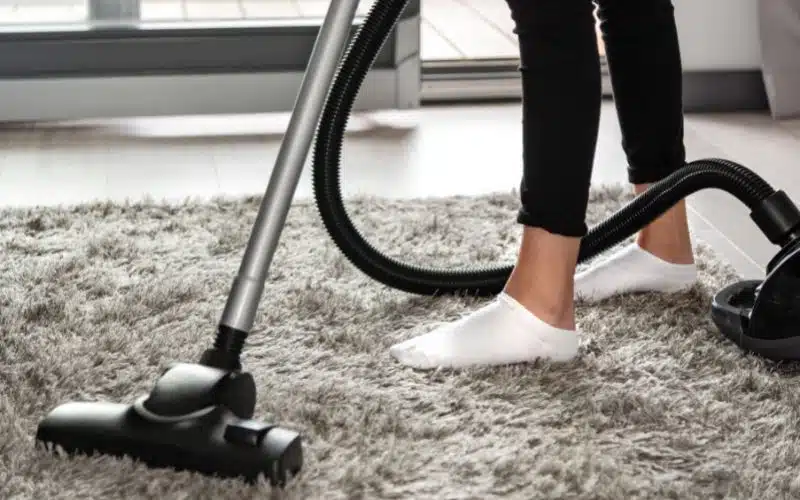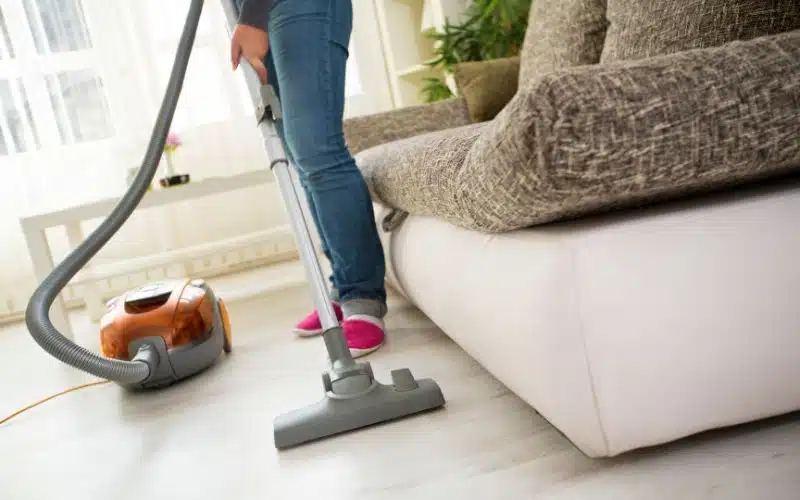All appliances have different parts that enable normal functioning of that appliance.
So what happens if a part is absent, will that appliance work properly? So like with other appliances, a vacuum cleaner is one.
A vacuum cleaner has several parts, and all of these have a specific role in the normal functioning of the vacuum.
A vacuum cannot work without a belt. It is between the motor and the brush roll and is responsible for allowing the brush to rotate so it can pick dirt. Your vacuum will turn on and make noises but cannot perform its function, and it will damage the vacuum if you continue to use it without a belt.
Does a Broken Vacuum Cleaner Belt Affect Suction?

The vacuum belt is an essential part of the vacuum cleaner, which enables suction.
Your vacuum cleaner may turn on and make a noise like it’s working correctly, but the roller brush is not spinning, making it unable to pick up dirt or dust.
Then this implies that the belt may break inside as the belt helps the roller brush to spin.
Do not panic because fixing a new vacuum belt is not difficult; you can do it just in the comfort of your home.
Steps to replace a vacuum belt:
- Get the vacuum belt you want to use for replacement
- Screw anticlockwise on the panel of the floor head
- Remove the roller brush
- Carefully remove the belt from the roller brush and the drive pulley (near the wheels at the rear part of the vacuum cleaner.
- Replace the belt with the new one and fix it correctly in its place
- Screw clockwise back the panel to fix the roller brush back in place.
Apart from a broken vacuum cleaner belt, other reasons also affect the vacuum cleaner’s suction.
#1. Tangled Or Stuck Debris in the Roller Brush
If the roller brush tangles with some hair or fabrics, it will reduce the rate of suction of your vacuum cleaner. You must cut the hair or fabrics on the brush and pull them out.
If your vacuum cleaner has a removable brush, it’ll be better as all you need to do is remove and clean the brush. Ensure to clean your brush regularly to avoid damage.
#2. Blocked Cleaning Tube
Use a light source to check the inside of your tube for any blockage or debris. If there is, it will reduce how your vacuum cleaner sucks dirt. Then, use something that can enter the tube to remove the blockage or dirt.
#3. Dirty Filters
When cleaning, some other dirt might get stuck in the filter. If you don’t remove it, it accumulates with time, reduces the cleaner’s suction, and can even damage the vacuum cleaner if not removed earlier.
What Happens If the Belt Breaks in Your Vacuum Cleaner?
Your vacuum cleaner belt is prone to wear and tear. With time, the belt undergoes stress or straining and gets worn out.
If the belt is broken inside the vacuum cleaner, the slowdown that the belt does to the motion of the motor will be absent.
It means the vacuum cleaner will become faster than usual, which will cause a lot of damage to the vacuum cleaner and, if not addressed, can damage the whole vacuum cleaner.
If you notice a jerk or hear a cracking sound from your cleaner, you can check the belt to see if it’s broken.
Also, if you perceive a smell of burnt rubber, it might be the belt burning as a result of the overwork of the cleaner.
Always check your vacuum cleaner to see if the belt or other parts needs replacement. It is better to fix only a part than to fix more than one or even change the vacuum cleaner.
Maintenance makes your appliance last long. Even if you have a quality cleaner and don’t maintain it, it’ll still not last long compared to a well-maintained cleaner.
Why Does My Vacuum Cleaner Belt Keep Breaking?
Vacuum belts stay for some time if maintained before they break or wear out; maintaining your vacuum belt will not only help the belt last long and the vacuum itself.
However, a broken vacuum belt can cause the breaking down of the cleaner itself, so you must always check and maintain your belts so they’ll last longer.
For a belt to break earlier than usual or even break regularly or often, there must be a problem with your vacuum cleaner.
These are a few reasons that can cause your vacuum cleaner belt to break earlier or even often:
#1. Tangled Dirt in the Roller Brush
If the roller brush is tangled, the belt might be spinning, but the brush will be spinning slowly; the friction caused by this movement can cause a break in the rear of the vacuum belt.
Therefore, cleaning your roller brush at least twice a month is always advisable to avoid dirt.
#2. Improper Fixing
Every part of the vacuum cleaner has a particular position where you fix it. If you fix it on the wrong part or even improperly, it can alter the standard functionality of the vacuum cleaner and can even cause damage.
Like other appliances, you must fix a belt properly to enable it to function correctly. If you place the belt wrongly, it might cause a break of the belt or even break the whole vacuum cleaner.
Every model has a way of fixing the belt, and if you do not know how to, you can check the manual, browse it, or contact a technician to fix it.
If you notice your roller brush isn’t spinning correctly, open it up to check if you placed the belt correctly.
And if you didn’t place it correctly, then ensure to pull it off and fix it properly to avoid a broken belt or vacuum cleaner.
#3. Wrong Belt
Though vacuum belts may look similar, they’re designed in different sizes and types to fit different models of vacuum cleaners.
Every belt is designed with a size to fit a particular model of the vacuum cleaner. Most vacuum cleaners have specifications of the style and size of their belts written on the machine.
But if you can’t find it on your cleaner, check the machine’s manual for the specifications of the number and style of a belt to function the vacuum cleaner properly.
If you use the wrong belt, it might brush on itself and cause the belt to burn. In addition, it can cause permanent wear of the belt.
This wear will cause a slower movement of the roller brush and eventually lead to the break of the belt. Check your belt if you perceive a smell of burnt rubber; it might be the one burning.
#4. Snagging
While vacuuming, avoid going over thick materials like towels, rugs, blankets, or the vacuum cleaner’s power cord.
When this happens, the cleaner’s belt might get stuck and cause overheating of the vacuum cleaner. When it is stuck, and you try using it, it might break or wear out.
Always change your belt every six months, though it might last more than that, to avoid breaking up in the vacuum cleaner.
When you use the belt over time, due to stretching, it becomes loose and not strong. As a result, it slows down the spinning of the roller brush and needs a replacement.
Below are the three essential parts of a vacuum cleaner that enables suction.
Can You Mend a Vacuum Cleaner Belt?
You might wonder if you can reuse your already broken vacuum belt if you can’t get a new one. Yes, you can use glue to glue the two ends of the belts.
After applying the glue, hold it in place for about 30 to 60 seconds. Then check if it’s firmly glued together.
Though this is not advisable as it will not last long and might break in the machine, at least it will serve a while before you’re able to get a new belt.
This method is not advisable if the break is not in one place or is big.
How Much Does It Cost to Replace a Vacuum Belt?
The cost for a new vacuum cleaner belt ranges from $2-$10 for singles and $3-$20 for two in one pack.
However, this depends on the vacuum cleaner belt’s size, style, and model. The vacuum belt is the cheapest in cost of replacement compared to other parts of a vacuum cleaner.
You can replace it in the comfort of your home but if you cannot replace it yourself, then feel free to contact a technician.
Conclusion
A vacuum cleaner belt is an essential part of the vacuum cleaner; if absent, the cleaner cannot perform its cleaning functions again.
Therefore, it would help if you always learned to fix your belts properly and always check for the specific belt used by your cleaner before getting a new one.
In addition, maintain your cleaner regularly and check for a loose vacuum belt to avoid breakage.





